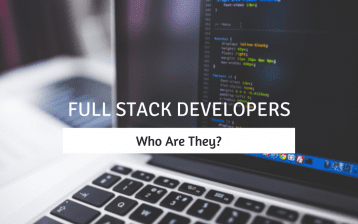Full stack web development and full-stack development are commonly used terms in software development, but they are often used interchangeably.
In this blog post, we’ll explore what these differences are and what skills are necessary for each role. Whether you’re considering a career in software development or want to understand the differences, this post will provide valuable insights and help clarify the distinction between full stack web development and full-stack development.
Full Stack Web Developer

Full-stack web development is a fascinating and rewarding field. As a full-stack web developer, you can bring ideas to life and impact the world by creating innovative and engaging websites and web applications.
But what is a full-stack web developer? Simply put, a full-stack web developer comprehensively understands a web application’s components, from the front-end user to the server-side back-end logic.
Take a closer look at what a full-stack web developer is responsible for:
- Front-end development: It involves using HTML, CSS, and JavaScript to create visually appealing and interactive user interfaces.
- Back-end development: It involves using languages such as Python, Ruby, or PHP and technologies such as Node.js to build the server-side logic that powers the application.
- Database management: A full-stack web developer must be able to design, implement, and manage databases that store and retrieve data for the web application.
- Deployment: Full-stack web developers must also be familiar with deploying web applications to production servers and maintaining them in a secure and scalable manner.
The skillset of a full-stack web developer provides a unique combination of technical and creative abilities that can lead to a range of exciting career opportunities. Whether you’re interested in building the next big e-commerce platform, designing innovative websites for small businesses, or developing cutting-edge web applications for Fortune companies, a career as a full-stack web developer offers endless possibilities.
So why should you consider becoming a full-stack web developer? Because it’s an industry that’s constantly evolving, providing you with opportunities to learn new technologies and develop your skills. Plus, the demand for full-stack web developers is increasing, making it an intelligent career choice with plenty of job opportunities.
Being a full-stack web developer allows you to make a real difference by building great web applications that positively impact people’s lives. If you’re searching for a challenging and rewarding career in technology, look no further than full-stack web development.
Differences between Full Stack Web Developer and Full Stack Developer
A Full Stack Web Developer is a software engineer specializing in developing client and server software for web applications. This typically involves working with HTML, CSS, and JavaScript for the front end and server-side languages such as PHP, Ruby, or Python for the back end. The developer ensures that all web application components work together seamlessly, from the user interface to the database.
A Full Stack Developer is a more general term that refers to a software engineer who can work on both the front-end and back-end of an application, regardless of the platform. This could include developing desktop applications, mobile applications, or other software systems. A Full Stack Developer may work with a broader range of technologies and programming languages and is not necessarily limited to web development.
In summary, a Full Stack Web Developer focuses specifically on web applications. In contrast, a Full Stack Developer has a broader skill set and can work on various software systems.
Learn data structures and algorithms with Imarticus Learning.
Through our Full-Stack Development certification course, students will learn database architecture and algorithms. During this six-month full stack developer online course, students will learn data structure algorithms and the technical facets of front-end and back-end programming.
Through online live interactive courses, the faculty will assist you in building a foundation for DSA and full-stack development. After weekly faculty training, the teaching assistants will answer questions through online sessions. On the weekends, the teaching assistants will also lead practical projects and practice sessions that you can join in person or online.
Course Benefits for Learners:
- We provide resume writing, profile improvement, workshops to help students prepare for interviews, and one-on-one career counseling as part of our career services.
- Establish a solid foundation in data structures while learning popular tools like Java, Spring, MongoDB, JavaScript, React, Docker, and Jenkins.
- Students can now participate in coding competitions run by our community project Skillenza to solve challenging business issues and stand out on resumes.



